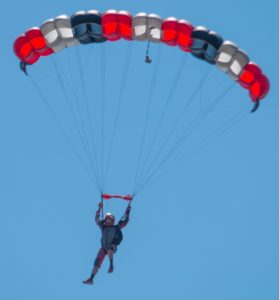 This is the last of my write ups for your parachute system, and is focused on that parachute most of us will never pack for ourselves, our reserve canopy.
This is the last of my write ups for your parachute system, and is focused on that parachute most of us will never pack for ourselves, our reserve canopy.
Expect to spend between $1,400 to $1,750 for a new reserve… more on used prices below. Your reserve is fundamentally different from your main canopy. Regardless of what you fly for your main, your reserve is a seven cell ram air canopy. It’s designed to open quickly and has more docile flight characteristics than your main canopy. This canopy can only be packed by an FAA Senior or Master rigger. After 180 days, if it has not been deployed, your reserve will need to be repacked by a rigger, giving him or her a chance to verify its airworthiness.
 AADs. Who needs ’em? Well, everyone who skydives, that’s who. If you fail to open your main parachute for any reason, your AAD will open your reserve at a predetermined altitude. The purpose of this article is not to explain how they work, I’ll cover that later. For now, a I’ll offer a few opinions on buying an AAD, and then share some other excellent resources on the Web from which you can learn so much more.
AADs. Who needs ’em? Well, everyone who skydives, that’s who. If you fail to open your main parachute for any reason, your AAD will open your reserve at a predetermined altitude. The purpose of this article is not to explain how they work, I’ll cover that later. For now, a I’ll offer a few opinions on buying an AAD, and then share some other excellent resources on the Web from which you can learn so much more.
